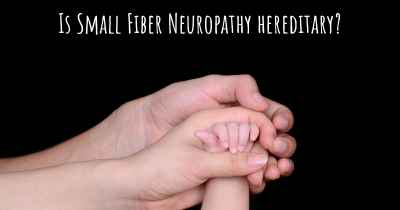What are the latest advances in Small Fiber Neuropathy?
Here you can see the latest advances and discoveries made regarding Small Fiber Neuropathy.

Small fiber neuropathy (SFN) is a disorder that affects the small nerve fibers in the peripheral nervous system. These fibers are responsible for transmitting sensory information, such as pain and temperature, from the skin to the brain. SFN can cause a range of symptoms, including burning pain, numbness, tingling, and sensitivity to touch.
Advances in the understanding and treatment of SFN have been made in recent years, offering hope for patients suffering from this debilitating condition. Here are some of the latest advances:
1. Improved diagnostic techniques:
Accurate diagnosis of SFN is crucial for effective management. Traditional diagnostic methods, such as nerve conduction studies and electromyography, are not sensitive enough to detect small fiber damage. However, newer techniques like skin biopsy and quantitative sensory testing have emerged as valuable tools for diagnosing SFN. Skin biopsy allows for the examination of nerve fiber density and morphology, while quantitative sensory testing assesses the patient's response to various sensory stimuli.
2. Identification of underlying causes:
Identifying the underlying cause of SFN is essential for targeted treatment. Recent research has shed light on various potential causes, including autoimmune disorders, metabolic conditions (such as diabetes), infections, and genetic mutations. By identifying these causes, healthcare professionals can tailor treatment plans to address the specific underlying condition.
3. Novel treatment options:
While there is no cure for SFN, several treatment options have shown promise in managing symptoms and slowing disease progression:
a. Immunomodulatory therapies: In cases where SFN is associated with autoimmune disorders, immunomodulatory therapies such as intravenous immunoglobulin (IVIG) and corticosteroids have been found to be effective in reducing pain and improving nerve function.
b. Nerve growth factor (NGF) inhibitors: NGF inhibitors, such as tanezumab, have shown potential in relieving pain associated with SFN. These drugs work by blocking the action of NGF, a protein involved in pain signaling.
c. Topical treatments: Compounded topical creams containing medications like lidocaine, capsaicin, and amitriptyline have been used to alleviate pain and improve sensory symptoms in SFN patients.
d. Lifestyle modifications: Lifestyle changes, such as maintaining a healthy weight, controlling blood sugar levels in diabetes, and avoiding triggers that worsen symptoms (such as extreme temperatures), can help manage SFN.
4. Research on regenerative therapies:
Regenerative therapies, including stem cell transplantation and growth factor administration, are being explored as potential treatments for SFN. These approaches aim to repair or regenerate damaged nerve fibers, offering the possibility of long-term symptom relief and functional recovery. While still in the early stages of research, these therapies hold great promise for the future of SFN treatment.
5. Patient support and advocacy:
Increased awareness and support for SFN patients have emerged in recent years. Patient advocacy groups and online communities provide a platform for sharing experiences, accessing information, and connecting with others facing similar challenges. These resources play a vital role in empowering patients and promoting research and development in the field of SFN.
In conclusion, advances in the diagnosis, understanding of underlying causes, and treatment options for small fiber neuropathy offer hope for patients suffering from this condition. Improved diagnostic techniques, identification of underlying causes, novel treatment options, research on regenerative therapies, and increased patient support and advocacy are all contributing to the progress in managing SFN. While there is still much to learn, these advancements bring us closer to improving the lives of individuals living with small fiber neuropathy.
Posted Jul 12, 2021 by Jo 3150








